Abstract
Looking at winter cabbage farming in Japan, the highest yield was 599kt nationwide, the highest cultivated area was 15kha, and Aichi had the highest shipping volume of 187kt. Past trends show that while harvest volumes have been stable nationwide, Aichi’s shipping volume is far ahead of other regions, indicating that the region is a major producer of winter cabbage. The area under cultivation is also showing a tendency to expand nationwide, indicating that production systems are being put in place to meet demand. Winter cabbage is a typical winter vegetable in Japan, and stable demand is thought to be leading to increased harvest and shipping volumes.
Winter cabbage harvest yield (main data).
Considering data from 1973 to 2022, Japan’s winter cabbage harvest peaked at 698kt nationwide in 1986. Since then, harvest volumes have declined compared to their peak and are currently at 85.7% of their peak. This trend is due to a variety of agricultural factors, but generally includes a decline in farmland, a decline in the agricultural labor force, and climate change. Shifts in demand and changes in agricultural policies also affect yields. On the other hand, it is also possible that technological innovation and improved agricultural productivity are leading to more efficient cultivation. Given this background, Japan’s winter cabbage harvest is down compared to past peaks, but it is also important to note that efforts are being made to improve the sustainability and efficiency of agriculture.
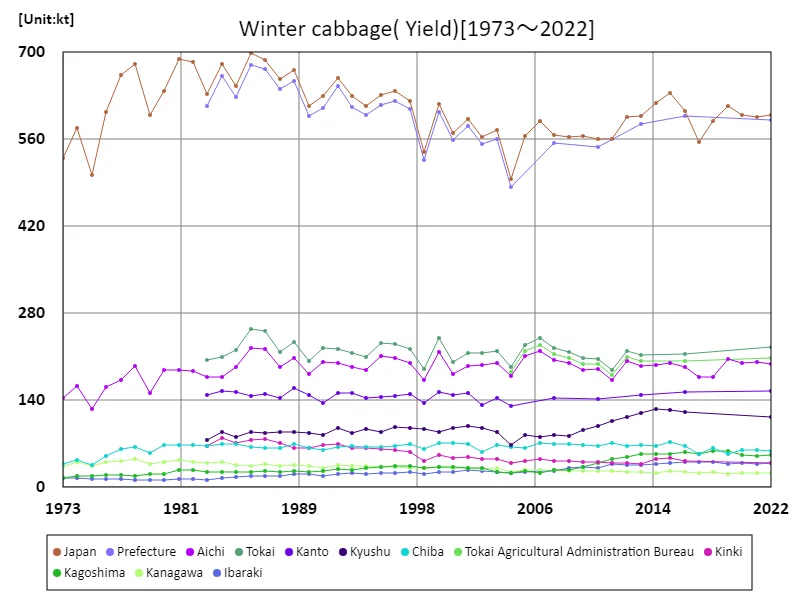

The maximum is 698kt[1986] of Japan, and the current value is about 85.7%
Winter cabbage harvest volume (by prefecture).
Looking at data for leafy vegetable harvests in Japan by prefecture for 2022, the highest overall was Aichi Prefecture at 199kt, which is the current maximum value. Past trends indicate that Aichi Prefecture is a major producer of leafy vegetables, with the largest harvest volume in the country. Leafy vegetable production in Aichi Prefecture is supported by local climatic conditions, developments in agricultural technology, and adaptation to market demand. Although leafy vegetables are cultivated in other prefectures, Aichi Prefecture’s production volume is overwhelming. Furthermore, leafy vegetables occupy an important position in Japan’s food culture, and it is believed that stable demand has led to increased production. In the future, technological innovation and the promotion of sustainable agriculture are likely to lead to further increases in leafy vegetable production.
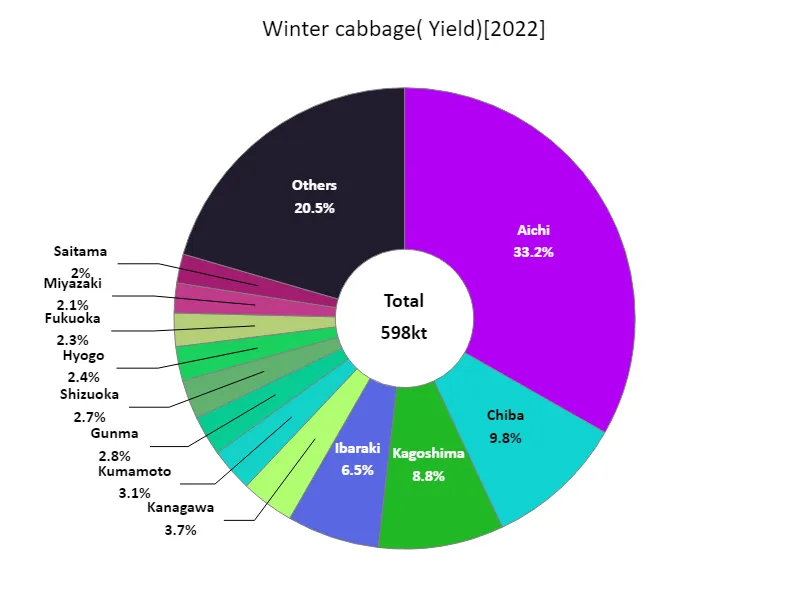

The maximum is 199kt of Aichi, the average is 13kt, and the total is 598kt
Area planted with winter cabbage (main data).
Looking at data from 1973 to 2022, the area of land planted with winter cabbage in Japan peaked at 17.8 kha nationwide in 1981. Since then, the area under cultivation has declined compared to its peak, and is currently at 84.3% of its peak. This trend is due to a variety of agricultural factors, but generally includes a decline in farmland, a decrease in the agricultural labor force, and changes in market demand. In particular, the urbanization of farmland and the aging of farmers are contributing to the decline in cultivated area. Changes in demand and import competition may also be affecting acreage. At the same time, efforts are being made to grow more crops on limited farmland through efforts to improve productivity and efficiency. Given this background, the area of land cultivated with winter cabbage in Japan has decreased compared to past peaks, but future measures such as promoting sustainable agriculture and adapting to market needs are necessary.
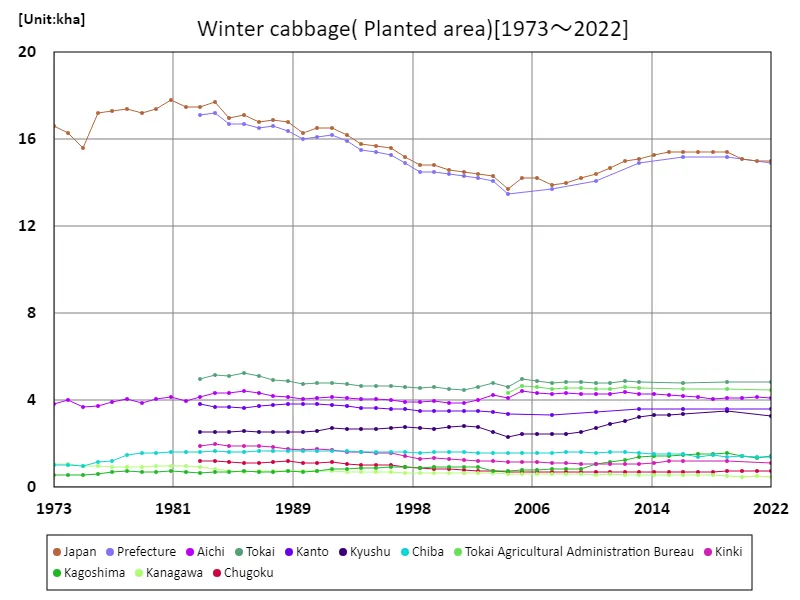

The maximum is 17.8kha[1981] of Japan, and the current value is about 84.3%
Area cultivated with winter cabbage (by prefecture).
Looking at data by prefecture for 2022, the largest area cultivated with leafy vegetables in Japan is Aichi Prefecture, at 4.11 kha. This is the current maximum value, and based on past trends, it appears that Aichi Prefecture is a major producing area for leafy stem vegetables. Aichi Prefecture has an environment suitable for producing leafy stem vegetables due to its climatic conditions, advances in agricultural technology, and adaptation to market demand. This is why the cultivated area is thought to be larger than in other prefectures. Furthermore, leafy vegetables occupy an important position in Japan’s food culture, and it can be said that stable demand has led to an increase in the production area. Furthermore, although leafy vegetable cultivation is carried out in areas outside Aichi Prefecture, the scale of cultivation tends to be relatively small. In the future, technological innovation and the promotion of sustainable agriculture are likely to lead to a further increase in the area cultivated with leafy vegetables.
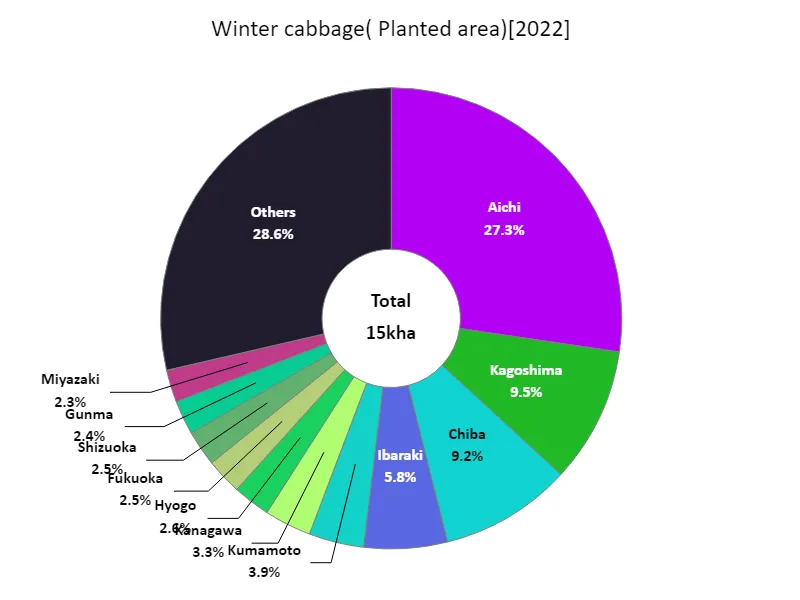

The maximum is 4.11kha of Aichi, the average is 327ha, and the total is 15kha
Winter cabbage shipment volume.
Overall shipments of winter cabbage in Japan in 2022 will be 543kt, with an average of 11.8kt. The largest overall shipping volume was in Aichi Prefecture, with 187kt, an overwhelming amount compared to other regions. This trend indicates that Aichi Prefecture is a major producer of winter cabbage. Aichi Prefecture has succeeded in increasing winter cabbage production by adapting to climatic conditions, advances in agricultural technology, and market needs. On the other hand, winter cabbage is also grown in other regions, but on a smaller scale. In addition, winter cabbage is one of Japan’s typical winter vegetables, and stable demand contributes to maintaining and increasing shipping volumes. Given this background, the increase in winter cabbage shipping volumes, mainly in Aichi Prefecture, is supported by a variety of factors, including improved agricultural productivity and flexible responses to market needs. In the future, with technological innovation and the promotion of sustainable agriculture, winter cabbage shipments are likely to increase further.
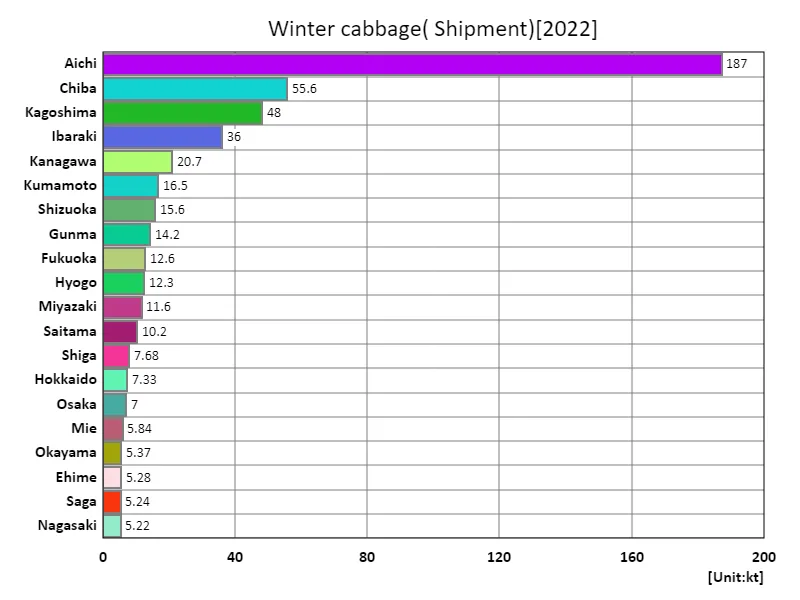

The maximum is 187kt of Aichi, the average is 11.8kt, and the total is 543kt
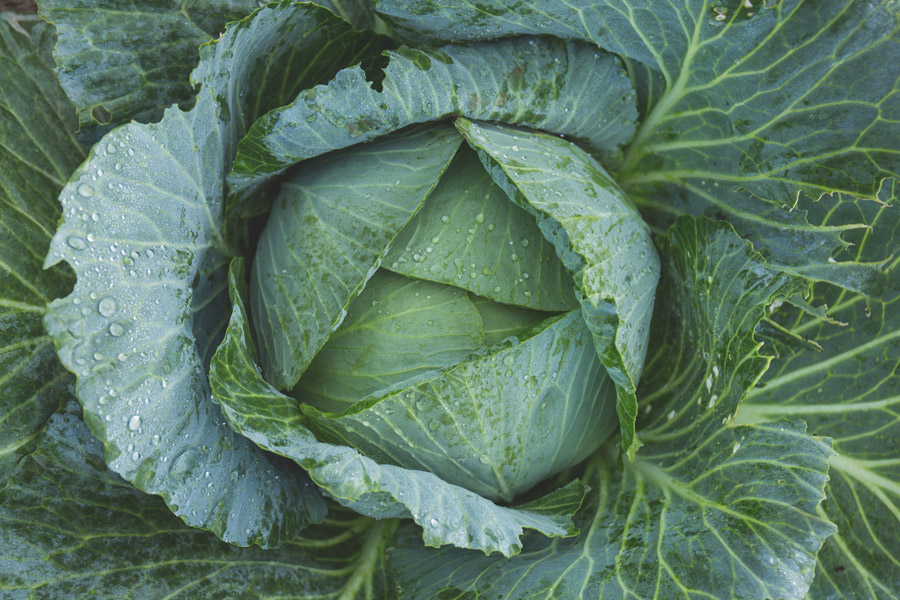


Comments